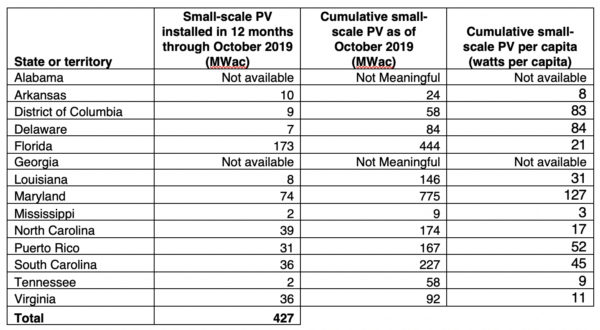Solar installers put up 427 MWac of small-scale PV systems in the 12 months ended last October, in the Southeastern region from Louisiana to Delaware, plus Puerto Rico.
Florida, with more than a quarter of the region’s population, punched above its weight, gaining 40% of the installations. Yet Maryland kept the lead in small-scale solar per capita, followed by Delaware and the District of Columbia, neck and neck at second and third. The three states all exceed the national average of 69 watts per capita.
About 5,100 MWac of small-scale solar will be added nationwide in 2020, projects the federal Energy Information Administration (EIA). That would be a big increase over the 3,600 MWac added in the 12 months ending October, 2019, and would represent a 23% gain over the current total of 22.5 GW — a respectable growth rate, if achieved. Small-scale solar is defined as any installation smaller than 1 MWac.
Here are the results for the 14 states and territories, as reported in EIA’s Form EIA-861M reports:

Source: author’s analysis of EIA-861M reports
EIA did not have meaningful data for Alabama or Georgia. Data for Puerto Rico are for net metering installations.
As some distributed PV systems are larger than 1 MWac, the actual amounts of residential, commercial, and industrial PV systems in each state are somewhat higher, but EIA does not collect data in that form. Distributed solar installations are defined as those not directly connected to the bulk power system.
Policy experts working in many of the 14 states and territories offered their goals for advancing distributed solar in the coming year:
Florida — community solar and stable fixed charges: The Florida Public Service Commission has “a big opportunity” to approve FPL’s proposed SolarTogether program, said Bryan Jacob, solar program director with the Southern Alliance for Clean Energy (SACE). “This program would double the amount of community solar in the U.S. over the next two years, and would enable low-income customers to participate,” he said. Vote Solar also backs the SolarTogether program, said Katie Ottenweller, the group’s Southeast director. On the other hand, SACE opposes “predatory fixed-charge increases in Florida and across the Southeast,” said Jacob.
Georgia — net metering: Following the Georgia Public Service Commission’s requirement that Georgia Power offer net metering for its rooftop solar customers, SACE aims to ensure “effective implementation” of that requirement, said Jacob. Meanwhile, Vote Solar plans to promote fair market access for independent solar generators, by engaging in an avoided cost proceeding, said Ottenweller.
South Carolina — fair valuation of solar: The South Carolina Public Service Commission will consider appropriate valuation for solar generation once net metering expires next year, said Bryan Jacob of SACE. “With four of seven Commission seats expiring in June, those elections, by the General Assembly, could have significant bearing on these solar valuations,” he said. SACE’s policy goal is to achieve fair valuation for future customers. The Solar Energy Industries Association (SEIA) is also engaging in the net energy metering successor tariff, said a spokesperson. Vote Solar sees an “opportunity for inclusive, affordable community solar programs” in the state, said Tyler Fitch, the group’s Southeast regulatory manager.
North Carolina — fair valuation of solar: As in South Carolina, ensuring fair valuation of solar for future solar customers will be a policy priority for SACE, said Jacob. The state’s Clean Energy Plan contemplates developing rates that “provide accurate price signals to customer-sited resources like energy efficiency and solar generation that reflect avoided costs and value to the grid,” he said. A SEIA spokesperson said the association is pursuing several policy goals that could help both the utility-scale and small-scale solar sectors. Vote Solar will be working to ensure that Duke Energy’s grid modernization proposal “enables distributed energy resources, and works for all ratepayers, especially after the company’s net-zero-by-2050 announcement,” said Fitch.
Virginia — broad legislative opportunity: SEIA’s regional affiliate MDV-SEIA is working to advance the Virginia Clean Economy Act, which would, among other advances, remove stand-by charges for residential solar systems, legalize power purchase agreements statewide, and increase the net energy metering cap from 1% to 10%, said Rachel Smucker, Virginia policy and development manager for MDV-SEIA. Vote Solar and SEIA are also supporting clean energy legislation in Virginia.
Tennessee and Alabama: With the termination of the Tennessee Valley Authority’s Green Power Providers program last year, Jacob said SACE expects “not much more” distributed solar across TVA’s seven-state region. In Alabama, he said, SACE does not anticipate much additional distributed solar “as long as Alabama Power maintains their punitive solar standby charge.” Yet the organization will continue to look for opportunities to promote responsible energy choices in the two states, he said.
This content is protected by copyright and may not be reused. If you want to cooperate with us and would like to reuse some of our content, please contact: editors@pv-magazine.com.








By submitting this form you agree to pv magazine using your data for the purposes of publishing your comment.
Your personal data will only be disclosed or otherwise transmitted to third parties for the purposes of spam filtering or if this is necessary for technical maintenance of the website. Any other transfer to third parties will not take place unless this is justified on the basis of applicable data protection regulations or if pv magazine is legally obliged to do so.
You may revoke this consent at any time with effect for the future, in which case your personal data will be deleted immediately. Otherwise, your data will be deleted if pv magazine has processed your request or the purpose of data storage is fulfilled.
Further information on data privacy can be found in our Data Protection Policy.